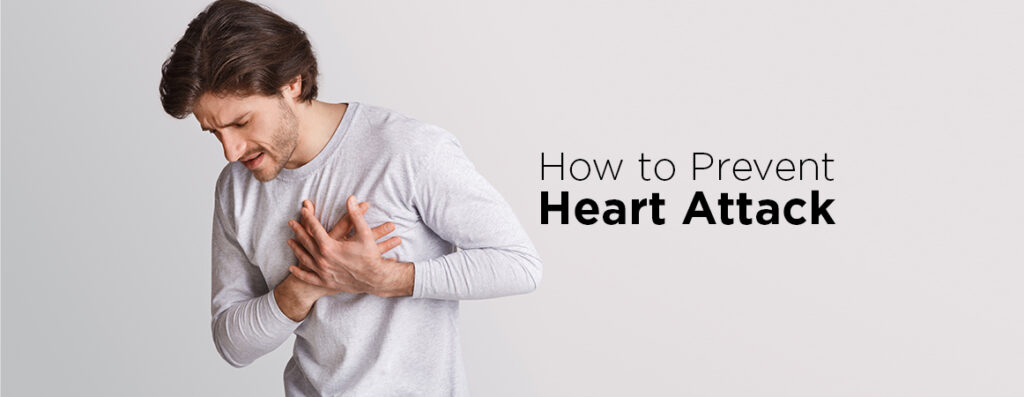How to Prevent Heart Attack?
What is a Heart Attack?
A heart attack, also known as a myocardial infarction, occurs when the flow of blood to a part of the heart is blocked for an extended period, leading to damage or death of heart muscle tissue. This blockage is typically caused by the buildup of plaque—a mixture of fat, cholesterol, and other substances—within the coronary arteries.
How to Prevent Heart Attack: Essential Lifestyle Changes
Taking proactive steps toward heart attack prevention is crucial, especially for individuals with a family history of heart disease. Here’s how to prevent heart attacks with lifestyle modifications:
1. Adopt a Heart-Healthy Diet
A heart attack prevention diet focuses on minimizing harmful fats, cholesterol, and sodium while increasing the intake of heart-healthy foods. Key dietary changes include:
- Reduce saturated fats and trans fats: Limit red meat, butter, and processed foods that are high in unhealthy fats.
- Increase fruits and vegetables: These are rich in fiber, vitamins, and antioxidants, all of which contribute to heart health.
- Opt for whole grains: Foods like brown rice, oats, and whole wheat contain fiber, which helps lower cholesterol.
- Eat healthy fats: Focus on unsaturated fats, such as those found in olive oil, nuts, seeds, and fatty fish like salmon, which are high in omega-3 fatty acids.
2. Exercise Regularly
Physical activity is essential for strengthening the heart and improving circulation. At least 30 minutes of regular exercise a day helps reduce blood pressure, cholesterol levels, and body weight, all of which contribute to heart attack prevention.
3. Quit Smoking
Smoking damages the blood vessels, leading to plaque buildup and an increased risk of heart attack. Quitting smoking is one of the most effective ways to prevent a heart attack, as it significantly reduces your risk within just a few years.
4. Manage Stress
Chronic stress contributes to high blood pressure and inflammation, both of which increase the likelihood of heart disease. Stress management techniques, such as meditation, yoga, deep breathing exercises, and adequate sleep, are essential for cardiac patient care and heart attack prevention.
Early Heart Attack Signs: What to Watch For
- Chest pain or discomfort: A sensation of pressure, tightness, or squeezing in the chest that may spread to the arms, neck, jaw, or back.
- Shortness of breath: Breathing difficulties that are frequently accompanied with chest pain.
- Nausea or lightheadedness: Feeling dizzy or faint, sometimes along with nausea or vomiting.
- Cold sweats: Sudden, excessive sweating, even without exertion.
- Fatigue: Unexplained extreme tiredness, particularly in women, may be an early warning sign.
If you experience any of these early heart attack signs, seek medical attention immediately at MMI Hospital.
Heart Attack Treatment: Options and Care
Heart attack treatment focuses on restoring blood flow to the heart muscle as quickly as possible. Early treatment can significantly reduce the damage caused by a heart attack. Common heart attack treatment options include:
- Medications: Blood thinners like aspirin, clot-busting drugs, and medications to lower blood pressure or cholesterol may be prescribed to restore blood flow and reduce the risk of future heart attacks.
- Surgical procedures: Surgery can be required in more serious situations. Stent insertion and angioplasty aid in the opening of clogged arteries, whereas coronary artery bypass surgery redirects blood flow to avoid a blocked artery.
- Cardiac rehabilitation: After treatment, cardiac patient care often involves rehabilitation programs that include monitored exercise, nutritional counseling, and stress management to support recovery.
Heart Attack Prevention Diet: Eating for Heart Health
A heart attack prevention diet can lower the risk of developing heart disease and other cardiovascular problems. Consider the following heart-friendly foods:
- Leafy greens: Spinach, kale, and other greens are packed with nutrients like potassium and magnesium, which help regulate blood pressure.
- Berries: Rich in antioxidants, berries like blueberries, strawberries, and raspberries can reduce inflammation and protect against heart disease.
- Nuts and seeds: Almonds, walnuts, flaxseeds, and chia seeds are excellent sources of heart-healthy fats, fiber, and minerals.
- Legumes: Beans, lentils, and chickpeas are rich in fiber and protein, making them a great plant-based alternative to meat for heart health.
Cardiac Patient Care: Long-Term Management
For individuals who have experienced a heart attack, cardiac patient care focuses on preventing future incidents and managing ongoing heart health. This includes regular medical check-ups, taking prescribed medications, and adhering to a heart-healthy lifestyle. Important elements of cardiac patient care include:
- Monitor blood pressure and cholesterol levels: Regularly checking these markers can help ensure they remain within a healthy range.
- Follow your doctor’s advice: Attend follow-up appointments and take medications as prescribed to support long-term recovery.
Conclusion
Knowing how to prevent heart attacks and recognizing early heart attack signs are crucial steps in maintaining cardiovascular health. By following a heart attack prevention diet, exercising regularly, quitting smoking, and managing stress, you can significantly reduce your risk. For those who have already experienced a heart attack, following a structured cardiac patient care plan can aid in recovery and prevent future episodes.
Post Disclaimer
The information contained in this post is for general information purposes only. The information is provided by "How to Prevent Heart Attack? "and while we endeavour to keep the information up to date.
Legal Disclaimer
We do not claim to cure any disease which is considered’ incurable ‘ on the basis of scientific facts by modern medicine .The website’s content is not a substitute for direct, personal, professional medical care and diagnosis. None of the medicines mentioned in the posts ,including services mentioned at "medicineguide.us" should be used without clearance from your physician or health care provider.
Testimonials Disclaimer– : Results may vary, and testimonials are not claimed to represent typical results. The testimonials are real, and these patients have been treated with homeopathy treatment from our clinic . However, these results are meant as a showcase of what the best, Medicine can do with their disease contions and should not be taken as average or typical results.


